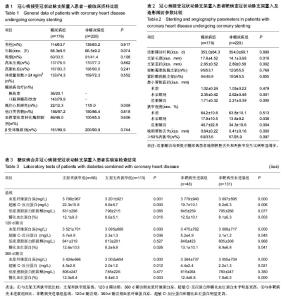| [1] Marroquin OC,Kip KE,Kelley DE,et al.Metabolic syndrome modifies the cardiovascular risk associated with angiographic coronary artery disease in women: a report from the Women’s Ischemia Syndrome Evaluation. Circulation. 2004;109(2): 714-721.
[2] Cho EJ,Kim JH,Sutradhar S,et al. Reduction in cardiovascular risk using a proactive multifactorial intervention is consistent among patients residing in Pacific Asian and non-Pacific Asian regions: a CRUCIAL trial subanalysis. Vasc Health Risk Manag. 2014;26(10):145-156.
[3] Kang SJ,Cho YR,Park GM,et al.Predictors for functionally significant in-stent restenosis: an integrated analysis using coronary angiography, IVUS, and myocardial perfusion imaging.JACC Cardiovasc Imaging.2013;6(11):1183-1190.
[4] Lim JY,Deo SV,Kim WS,et al.Drug-eluting Stents versus Coronary Artery Bypass Grafting in Diabetic Patients with Multi-vessel Disease: A Meta-analysis. Heart Lung Circ.2014.
[5] Grundy SM,Cleeman JI,Daniels SR.Diagnosis and management of the metabolic syndrome: an American Heart Association/National Heart, Lung, and Blood Institute scientific statement.Circulation.2005;112(5):2735-2752.
[6] Morice MC,Serruys PW,Sousa JE,et al.A randomized comparison of a sirolimus-eluting stent with a standard stent for coronary revascularization.N Engl J Med. 2002;346(23): 1773-1780.
[7] 王晓东.不同种类冠状动脉支架生物相容性与置入后血管再狭窄[J].中国组织工程研究与临床康复,2009,13(9):1699-1702.
[8] 王雪芳,刘艳明.心血管支架材料生物力学及生物相容性与置入后血管再狭窄[J].中国组织工程研究与临床康复, 2010,14(34): 6409-6412.
[9] 李雪峰,徐晶,游陆,等.雷帕霉素洗脱支架和紫杉醇洗脱支架置入在冠状动脉病变治疗中的生物安全性:2年随访[J].中国组织工程研究与临床康复,2008,12(30):5807-5810.
[10] World Health Organization.Multinational Monitoring of trends and determinants in cardiovascular disease (MONICA Project) and mannual of operation. Cardiovascular Disease Unit, Geneva,1983.
[11] American Diabetes Association. Standards of medical care for patients with diabetes mellitus. Diabetes Care.1997;20(Suppl 1):5-13.
[12] Sardi GL,Loh JP,Torguson R,et al.Drug-eluting stents in patients on chronic hemodialysis: Paclitaxel-eluting stents vs. limus-eluting stents.Cardiovasc Revasc Med.2014.
[13] West NEJ,Ruygrok PN,Disco CMC, et al. Clinical and angiographic predictors of restenosis after stent deployment in diabetic patients.Circulation.2004;109(8):867-873.
[14] Ielasi A,Latib A,Colombo A.The diabetic dilemma: which drug-eluting stent works best? Minerva Cardioangiol. 2014; 62(1):39-57.
[15] Hong SJ,Kim MH,Ahn TH,et al.Multiple predictors of coronary restenosis after drug-eluting stent implantation in diabetic patients. Heart.2006;92(4):1119-1124.
[16] Moussa I,Leon MB,Baim DS.Impact of sirolimus eluting stents on outcome in diabetic patients. A SIRIUS (Sirolimus-Coated Bx Velocity Balloon-Expandable Stent in the Treatment of Patients With De Novo Coronary Artery Lesions) substudy. Circulation.2004;109(3):2273-2278.
[17] Viviani AC,Briguori C,Roncarati R,et al.Routine assessment of on-clopidogrel platelet reactivity and gene polymorphisms in predicting clinical outcome following drug-eluting stent implantation in patients with stable coronary artery disease. JACC Cardiovasc Interv.2013;6(11):1166-1175.
[18] Aloke VF,Jae SO,Michael H,et al. Predictive factors for in-stent late loss and coronary lesion progression in patients with type 2 diabetes mellitus randomized to rosiglitazone or placebo. Am Heart J.2009;157(383):e1-e8.
[19] Natarajan MK,Strauss BH,Rokoss M,et al.Randomized trial of insulin versus usual care in reducing restenosis after coronary intervention in patients with diabetes. the STent Restenosis And Metabolism (STREAM) study.Cardiovasc Revasc Med. 2012; 13(2):95-100.
[20] Siller-Matula JM,Delle-Karth G,Lang IM,et al.Phenotyping vs. genotyping for prediction of clopidogrel efficacy and safety: the PEGASUS-PCI study. Thromb Haemost. 2012;10(4): 529-42.
[21] Brener SJ,Mehran R,Dressler O,et al.Diabetes mellitus, myocardial reperfusion, and outcome in patients with acute ST-elevation myocardial infarction treated with primary angioplasty (from HORIZONS AMI). Am J Cardiol.2012; 109(8):1111-1116. |

